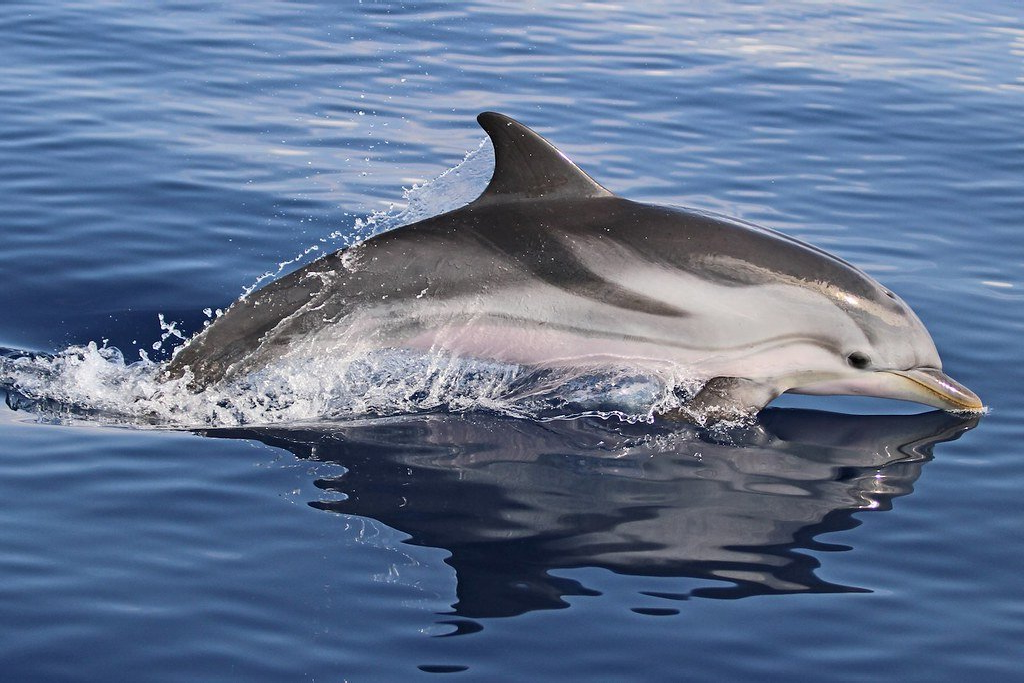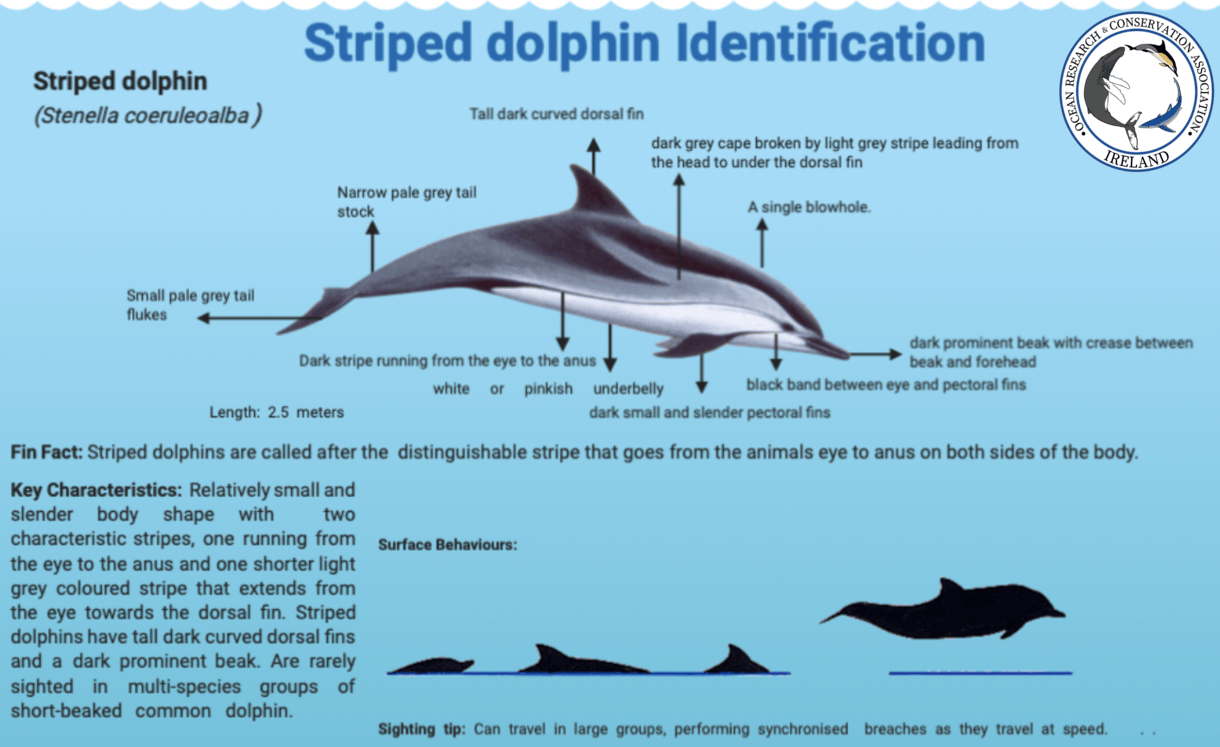Striped Dolphin
(Stenella coeruleoalba)
Classification:
Kingdom: Animalia
Phylum: Chordata
Class: Mammalia
Order: Artiodactyla
Infraorder: Cetacea
Family: Delphinidae
Genus: Stenella
Species: S. coerileoalba
Get the Facts:
Striped dolphins are one of the most abundant dolphin species around the world. They are sometimes called “streakers” because the swim very fast when trying to avoid vessels. This species is known to be very social and acrobatic. For example, when they make high jumps, they rotate their tail just before entering back into the water. This is called roto-tailing. Other well-known characteristic of striped dolphins is their striking and unique colour pattern, that is the reason why their specific name is “coerileoalba”.
Species Identification:
Striped dolphins have a long beak, round forehead and a falcate dorsal fin. The mean body length for adult males is 2,4 m and for adult females is 2,2 m, and weigh 160 kg and 150 kg respectively. Calves are usually up to a meter long and weigh approximately 10 kg. Striped dolphins can be confused sometimes with other dolphin species, but they are recognised by their bold grey and white colour pattern. They have thin dark grey or bluish black stripes that extend from the eye to the flipper and another set from the eye to the anus. The dorsal cape is muted grey or bluish-grey and sometimes it mixes with a white or light-grey spinal blaze that flows from the lateral flanks. Their beak, tapered flipper and tail are dark blue/grey. They also have a dark blue patch around their eyes and their underbelly is white to pinkish. Their coloration and markings may vary across individuals and their geographic location.
Diet:
The diet of striped dolphins consist mainly on a variety of pelagic or benthopelagic fish, crustaceans and cephalopods, such as squids. Depending on their geographic location and season, they will give preference to a certain type of food. For example, in the coastal waters of Japan and South Africa and in the oceanic waters of the Northeast Atlantic, lantern fish is the dominant prey. Whereas, in the coastal waters of the Northeast Atlantic they prefer cod and anchovy and in the Mediterranean they feed mainly on squid. They usually forage at dusk or the early night and can dive to depths between 200m and 700 m in order to reach their potential prey.
Habitat:
Striped dolphins are usually found in deep offshore waters with temperatures ranging from 10 to 26 °C. They are also attracted to upwelling areas (nutrient-rich waters come to the surface) and convergence zones (where currents meet). In Ireland, striped dolphin have been sighted in offshore waters along the continental shelf, however most of what is known about them here is from stranding records on along the west and south coasts.
Behaviour:
Striped dolphins are social and are usually found in pods averaging between 5 to 500 individuals. They do not often “bow ride” in front of a vessel like other dolphins. They tend to be very active and they are capable of performing different aerial acrobatics such as breaching, somersaults, leaping, chin slaps and roto-tailing. They can even leap a distance seven times their size. Striped dolphins are very fast swimmers and can reach a speed of 15 km/hour. When travelling at top speed, a third of the members of the pod can be above surface at the same time.
Social Structure:
Three types of pods have been identified: juvenile, adult and mixed. The adult and mixed groups are further divided into breeding and non-breeding pods. A calf will remain in adult pod until they are 1 or 2 years old, after that they leave and join a juvenile pod. Juvenile pods migrate closer to the coasts compared to adult and mixed pods. When females reach sexual maturity, most of them will rejoin adult non-breeding pods but some directly rejoin adult breeding pods. In the case of sexual mature males, they will rejoin adult non-breeding or breeding pods in equal numbers. An adult male may leave the pod and join other if there no more females to mate with. The breeding system is likely to be polygynous (a male reproducing with several females), but there indications that polyandry can occur (a female reproducing with several males).
Reproduction:
Striped dolphin reproduction is seasonal, where most of the calves are born in summer or winter. The gestation lasts up to 12 to 13 months and the estimated lactation is 15 months. Weaning is usually complete when the calf is two years old. Males reach sexually maturity at an age between 7 and 15 years, and females between 5 to 13 years. It is believed that females have a calf every three years.
Vocalisations:
Striped dolphins produce a series of echolocation whistles (up to more 20 kHz), clicks (between 50 to 150 kHz) and bursts. Their acoustic activity is higher from dusk to dawn which corresponds with their preferred foraging hours. There are also indications that the acoustic features of whistles vary with their geographic location.
Lifespan:
The lifespan estimated for both male and female striped dolphins is 57.5 years.
Global Distribution:
Striped dolphins are widely distributed in tropical to warm temperate oceanic waters in both hemispheres. Their range extends from the western and eastern North and Tropical Pacific, and from the Atlantic coast of northern South America up to eastern North America. They have also been recorded in the eastern North Atlantic south of the UK and in the Mediterranean. Striped dolphins have been spotted in the Indian Ocean, however their range there is not fully known.
Population Status:
The estimated population of striped dolphins is 570.000 in the western North Pacific, 1.5 million in the eastern North and and Tropical Pacific and 118.000 in the the Mediterranean. The IUCN lists the species as “Least Concern (LC)” due to their abundance. Nonetheless, the Mediterranean subpopulation is currently listed as “Vulnerable (VU)” due to almost a 30% reduction over the last 60 years.
Threats to Survival:
During the mid-20th century, the western Pacific population suffered high mortality rates due to hunting activities by Japan. Annual catches were between 8.000 to 9.000 dolphins, and it even reached 21.000 some years. Nowadays, the hunting of striped dolphins still goes on in Japan but on a smaller scale with annual catches below 1000 individuals. Other threat for this species is entanglement or accidental catching in fishing gear such as trawls. Some of these incidental catches have occurred in the eastern Tropical Pacific, western Mediterranean and the northeastern Atlantic. In the early 1990’s, there was an outbreak of morbillivirus which was lethal for the striped dolphin. Nearly 1.000 dolphins were found dead in the Mediterranean Sea. It was also found that the dead animals had high levels of pollution which probably caused them to have a low immunity to the disease. Striped dolphins seem to be susceptible to heavy metal pollution with recorded levels of mercury at 1.544 ppm.






